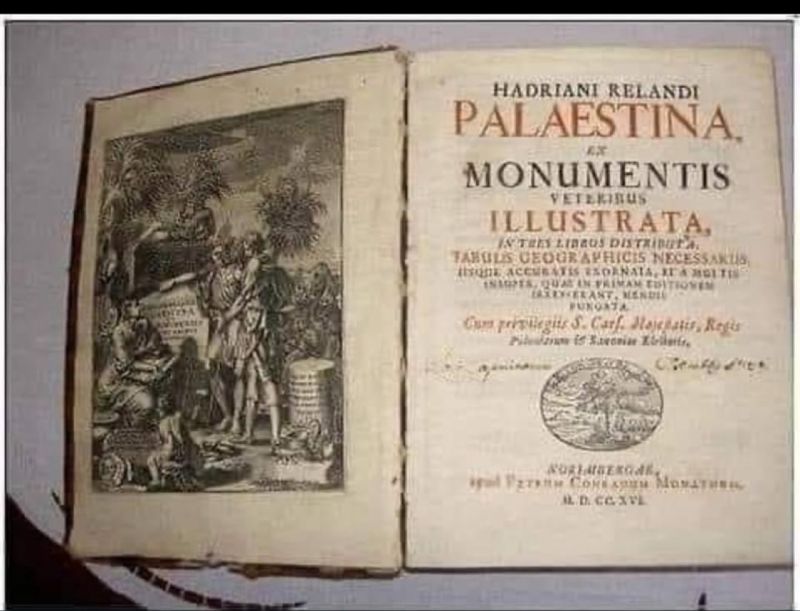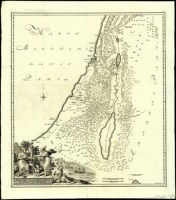Paleaestina ex Monumentis Veteribus Illustrata by Adriani Rilandi, a Census of Palestine in 1695
November 21, 2023
Paleaestina ex Monumentis Veteribus Illustrata

I do not know who wrote the following, but others seem to verify this is accurate.
Book "Palestina ex Monumentis Veteribus Illustrata". The book is written in Latin. In 1695. Rilandi was describing what was then called Palestine.
The author Adriani Rilandi is a geographer, cartographer, traveler, philologist, he knew several European languages, Arabic, ancient Greek, Hebrew.
He meticulously documented nearly 2,500 settlements mentioned in the Bible. His research was conducted as follows:
- He first created the map of Palestine. He then designated every settlement mentioned in the Bible or the Talmud with its original name.
- If the original was Jewish, it meant "pasuk" (a suggestion in the Holy Scriptures that mentioned the name.)
- If the original was Roman or Greek, the connection was in Latin or Greek.
In the end, he compiled a census of the population based on these settlements. Here are some key findings and facts:
- The country is mainly empty, abandoned, sparsely populated, the main population is Jerusalem, Akko, Tsfat, Jaffa, Tveria and Gaza.
- Most of the population is Jews, almost everyone else is Christians, very few Muslims, mostly Bedouins.
- The only exception is Nablus (now Shchem), where approximately 120 people from the Muslim family Natsha and approximately 70 "shomronims" (Samaritans).
- In Nazareth, the capital of Galilee, lived approximately 700 people - all Christians.
- In Jerusalem there are about 5,000 people, almost all Jews and a few Christians.
- In 1695, everyone knew that the origin of the country was Jewish.
- There is not a single settlement in Palestine that has Arabic roots in its name.
- Most settlements have Jewish originals, and in some cases Greek or Roman Latin.
- Apart from the city of Ramla, there is no Arab settlement that has an original Arabic name. Jewish, Greek or Latin names that have been changed to Arabic that don't make any sense in Arabic. In Arabic, there is no meaning in names like: Akko, Haifa, Jaffa, Nablus, Gaza or Jenin, and names like Ramallah, al-Khalil (Hebron), al-Quds (Jerusalem) - they do not have philological or historical Arabic roots. So, for example, in 1696, Ramallah was called Bethel (Beit El, the House of God), Hebron was called Hebron and the Cave of Mahpel was called El-Khalil (the nickname of Abraham) by the Arabs.
- Relandi mentions Muslims only as nomadic Bedouins who came to the cities as seasonal workers in agriculture or construction.
- About 550 people lived in Gaza, half of them Jews and half Christians. Jews were successful in agriculture, especially in vineyards, olives and wheat, Christians were engaged in trade and transportation.
- In Tiberias and Safed, Jews lived, but their occupations were not specified, except for their traditional fishing activities in the Sea of Galilee.
- In the village of Umm al-Fahm, there were about ten families, all of whom were Christians (approximately 50 people). There was a small Maronite church in the village.
Reland's book thoroughly refutes theories about "Palestinian traditions" and a "Palestinian people" and establishes very little connection between this land and the Arabs, who even adopted the Latin name of the land (Palestine) and claimed it as their own.
Book by Adrian Reland (1676-1718) about Palestine, published in Utrecht in 1714.
National Library of Israel - Book by Hadriani Relandi Palaestina ex Monumentis Veteribus Illustrata
National Library of Israel - Map Facies Palestinae ex Monumentis Descripta ab Hadriano Relando; Puschner Sculpsit
Map for Paleaestina ex Monumentis Veteribus Illustrata - see full size 22 mb
